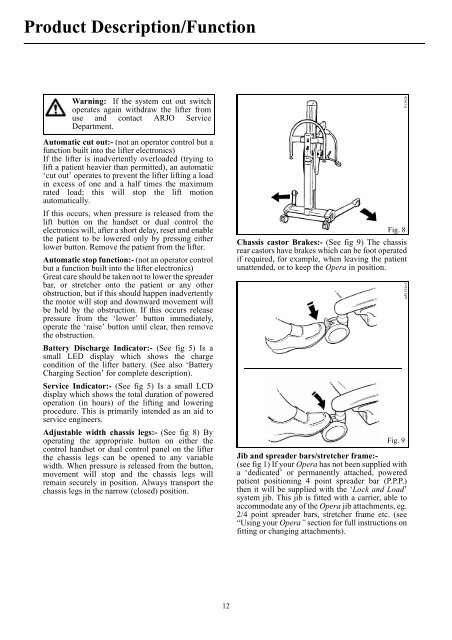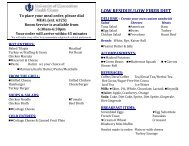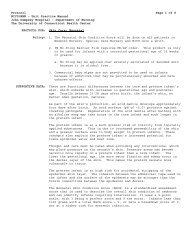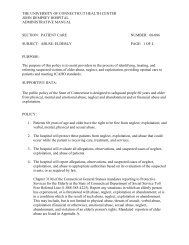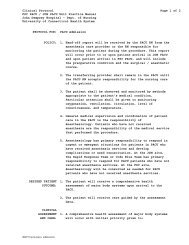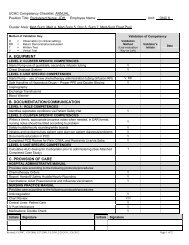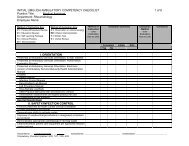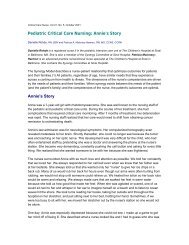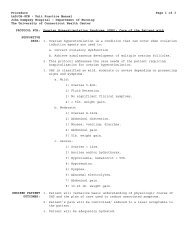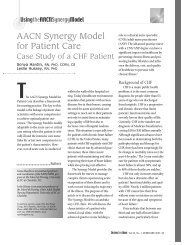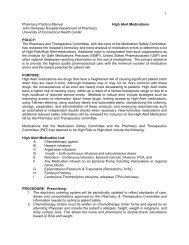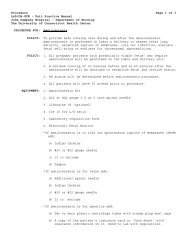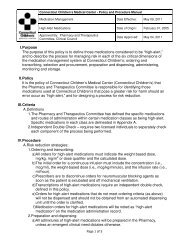You also want an ePaper? Increase the reach of your titles
YUMPU automatically turns print PDFs into web optimized ePapers that Google loves.
Product Description/FunctionWarning: If the system cut out switchoperates again withdraw the lifter fromuse and contact ARJO Service<strong>Department</strong>.Automatic cut out:- (not an operator control but afunction built into the lifter electronics)If the lifter is inadvertently overloaded (trying tolift a patient heavier than permitted), an automatic‘cut out’ operates to prevent the lifter lifting a loadin excess <strong>of</strong> one and a half times the maximumrated load; this will stop the lift motionautomatically.If this occurs, when pressure is released from thelift button on the handset or dual control theelectronics will, after a short delay, reset and enablethe patient to be lowered only by pressing eitherlower button. Remove the patient from the lifter.Automatic stop function:- (not an operator controlbut a function built into the lifter electronics)Great care should be taken not to lower the spreaderbar, or stretcher onto the patient or any otherobstruction, but if this should happen inadvertentlythe motor will stop and downward movement willbe held by the obstruction. If this occurs releasepressure from the ‘lower’ button immediately,operate the ‘raise’ button until clear, then removethe obstruction.Battery Discharge Indicator:- (See fig 5) Is asmall LED display which shows the chargecondition <strong>of</strong> the lifter battery. (See also ‘BatteryCharging Section’ for complete description).Service Indicator:- (See fig 5) Is a small LCDdisplay which shows the total duration <strong>of</strong> poweredoperation (in hours) <strong>of</strong> the lifting and loweringprocedure. This is primarily intended as an aid toservice engineers.Adjustable width chassis legs:- (See fig 8) Byoperating the appropriate button on either thecontrol handset or dual control panel on the lifterthe chassis legs can be opened to any variablewidth. When pressure is released from the button,movement will stop and the chassis legs willremain securely in position. Always transport thechassis legs in the narrow (closed) position.Fig. 8Chassis castor Brakes:- (See fig 9) The chassisrear castors have brakes which can be foot operatedif required, for example, when leaving the patientunattended, or to keep the Opera in position.Fig. 9Jib and spreader bars/stretcher frame:-(see fig 1) If your Opera has not been supplied witha ‘dedicated’ or permanently attached, poweredpatient positioning 4 point spreader bar (P.P.P.)then it will be supplied with the ‘Lock and Load’system jib. This jib is fitted with a carrier, able toaccommodate any <strong>of</strong> the Opera jib attachments, eg.2/4 point spreader bars, stretcher frame etc. (see“Using your Opera” section for full instructions onfitting or changing attachments).P1392bmP1332e,f12


